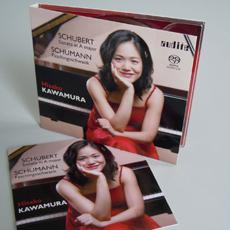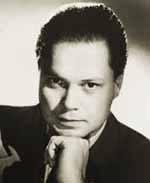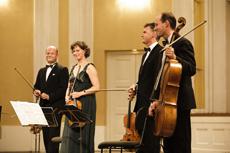„Mit jedem Werk, das die Geschwister Schmidt sowie Bratschist Roland Glassl als "Mandelring Quartett" der finalen 15 näherbrachte, steigerte sich die Intensität im Spiel der Musiker – sofern man das seriös behaupten kann nach zwölf Konzertstunden binnen zwei Tagen einer Streichquartett-Integrale, die uns noch lange beschäftigen wird … schlichtweg atemberaubend. “ (Salzburger Volkszeitung, 22.8.11)
„… überzeugt das Mandelring Quartett durch seine spieltechnische Präzision. … Die Hörerschar in Salzburg blieb indes tief bewegt bis zum bitteren Ende …“ (Frankfurter Allgemeine Zeitung).
„… dem Mandelring Quartett gelingen die vielfältigsten Spielfacetten von spröden, fast knochigen Linien über zerbrechliche Figurationen und unterschiedliche Ausdrucksstadien des Tänzerischen, eine reiche Skala dynamischer Valeurs bis hinein in den verstummenden Klang bis zu hoch energetischen, dramatischen bis drastischen Ausbrüchen. Ein denkwürdiges, so bald nicht wiederholbares Festspielerlebnis.“ (Salzburger Nachrichten).
„Dass das Mandelring-Quartett einen betont "objektiven", sachlichen – dabei nie blutleeren – Zugang pflegt, erhöhte die Wirkung noch, gerade bei Werken wie dem Quartett Nr. 11 in f-Moll mit seinen einfachen, kargen Motiven, die sich so richtiggehend ins Gehirn brennen.“ (Die Presse).
„Besonders beeindruckend die langsamen Sätze, die unter den Bögen der Mandelrings eine unglaubliche Tiefe bekamen." (Oberösterreichische Nachrichten, 20.8.11).
„Standing Ovations für die „enzyklopädische Anstrengung dieser Gesamtaufführung aller Schostakowitsch-Streichquartette an zwei Tagen“ (Frankfurter Rundschau).
„Als nach vier Konzerten in zwei Tagen am Freitag nach 22 Uhr im Mozarteum das Mandelring Quartett die letzten, kargen, leise verwehenden Töne des 15. Streichquartetts von Schostakowitsch „auslebte“, war es endlich Zeit, sich zu Standing Ovations zu erheben. Angemessener wäre die pure Stille nach der nach und nach großartiger und intensiver werdenden, einzigartigen Kunstanstrengung gewesen, aber sie hätte die Dankbarkeit nicht adäquat ausgedrückt, die man Sebastian, Nanette und Bernhard Schmidt und Roland Glassl für ihre enorme Leistung der Gesamtaufführung aller Schostakowitsch-Streichquartette zollen musste. … Ein denkwürdiges, so bald nicht wiederholbares Festspielerlebnis.“ (Salzburger Nachrichten, 22.8.11)
„Fulminantes Mandelring Quartett in Salzburg - Eine Sternstunde der Musik Beinahe 30 Jahre Quartettpraxis, und das noch unter Geschwistern und Freunden, ist absoluter Garant für perfektes Zusammenspiel. Wenn dann noch künstlerischer Ehrgeiz dazukommt und man im Rahmen der Salzburger Festspiele an zwei Tagen den wohl bedeutendsten Quartettzyklus des 20. Jahrhunderts, Schostakowitschs 15 Quartette, aufführt, dann kann aus so einem Projekt eine Sternstunde werden. Und das war am Donnerstag im großen Saal des Mozarteums mit dem Mandelring Quartett der Fall. … Das Mandelring Quartett konnte wieder einmal seine unnachahmlichen Eigenschaften ausspielen. Besonders beeindruckend die langsamen Sätze, die unter den Bögen der Mandelrings eine unglaubliche Tiefe bekamen.“ (Oberösterreichische Nachrichten, 20.8.11)
„Zu bewundern ist das Mandelring Quartett. Sebastian, Nanette und Bernhard Schmidt sowie Roland Glassl (Viola) arbeiten konzentriert Nuancen und Feinheiten heraus, steigern sich in die brutalen Rausch-Kaskaden hinein, ohne die Kontrolle über Ton und Klang preiszugeben. Sie sind dem Werk kongeniale Exekutoren.“ (DrehPunktKultur.at, 19.8.11)
Das Mandelring Quartett brachte mit seinen Auftritten am 18. und 19. August einen kompletten Schostakowitsch-Zyklus mit allen 15 Streichquartetten des Komponisten zu gehör. Das Ensemble präsentierte damit den wohl bedeutendsten Quartett-Zyklus des 20. Jahrhunderts. Die Streichquartette von Schostakowitsch legen Zeugnis ab vom Schaffen des Komponisten über fast ein halbes Jahrhundert – vom ersten Quartett des Zweiunddreißigjährigen 1938 bis zum letzten Werk 1974, im Jahr vor seinem Tod. Bereits 2009 komplettierte das Mandelring Quartett seine viel beachtete Gesamteinspielung der Werke bei audite. Sie wurde mehrfach mit Preisen ausgezeichnet und von der Fachpresse als eine der herausragenden Gesamteditionen unserer Zeit beurteilt: „ […] auf oberstem Niveau! Diese ganz erstaunliche Leistung zählt umso mehr, als diesen komplexen Werken durch Virtuosität oder spieltechnische Makellosigkeit allein nicht beizukommen ist.“ (FonoForum). „Dem Mandelring Quartett aber bleibt das Verdienst, von einem der größten Quartett-Zyklen des 20. Jahrhunderts eine neue Referenz-Aufnahme vorgelegt zu haben.“ urteilte BR-Klassik. „Die Musiker gehen in der neuen Einspielung noch über das bereits Erreichte hinaus [...] Das überraschendste an der Interpretation des Mandelring Quartetts ist dann aber, wie 'schön' sie ist, trotz aller Zerrissenheit, Trauer, Klage, Verzweiflung, die das Werk ausdrückt. Fast schon zum Weinen schön. So wirkt musikalische Wahrheit“, bringt es Pizzicato auf den Punkt. Das international führende Strad Magazine schrieb: „ […] the Mandelring Quartet makes it abundantly clear that it is building one of the outstanding cycles in today's catalogue." Hinter einem der profiliertesten Ensembles der internationalen Kammermusikszene verbergen sich die drei Geschwister Schmidt – Nanette (Violine), Sebastian (Violine) und Bernhard (Violoncello) – sowie Roland Glassl (Viola). Markenzeichen des Mandelring Quartetts sind seine Expressivität und seine phänomenale Homogenität in Klang, Tongebung und Phrasierung. Zahlreiche CD-Aufnahmen, mehrfach mit dem Preis der Deutschen Schallplattenkritik ausgezeichnet und für den Cannes Classical Award sowie den International Classical Music Award nominiert, belegen die außergewöhnliche Qualität und das breite Repertoire des Quartetts. Konzertreisen führen die Musiker in die berühmten Musikzentren Europas, Nord- und Südamerikas, des Nahen wie des Fernen Osten. 1997 gründete das Quartett sein jährlich stattfindendes HAMBACHERMusikFEST; seit 2009 hat es eigene Konzertzyklen in der Berliner Philharmonie und in seiner Heimatstadt Neustadt an der Weinstraße. Mehr Informationen auf www.mandelring.com.
Photo credit: © Wolfgang Lienbacher





